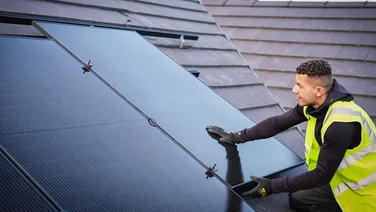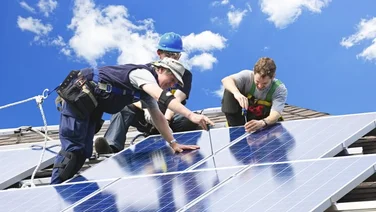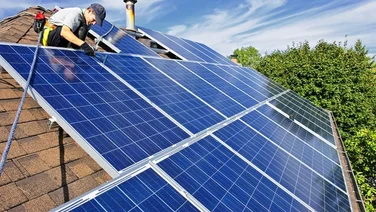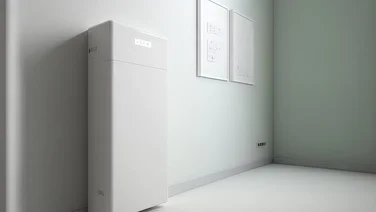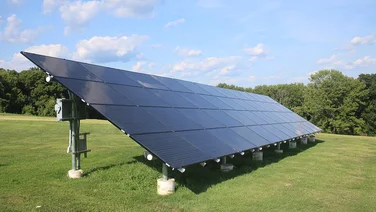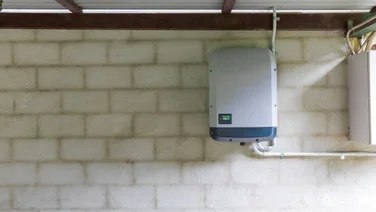- The Complete Guide to Solar Energy: what’s on this page?
- How has renewable energy evolved over time?
- Solar energy: what is solar power?
- Types of solar energy
- How does solar power work?
- How is solar energy stored?
- Solar energy facts
- Solar energy: the advantages and disadvantages
- Solar power vs non-renewable energy sources
- Solar power vs other renewable energy sources
- Should you get solar power for your home?
✔ The cost of solar power has dropped by nearly 70% since 2010
✔ Solar power is a key player in the renewable energy revolution
✔ Get the lowdown on the future in our comprehensive guide
We all want to end climate change and await the gratitude of future generations, who will inevitably shower us with praise for taking action to rescue their world from sure-fire destruction. And with the cost of solar panels, wind, and hydropower dropping, now is the time to act.
The stats show how much we want environmentally friendly solutions. A recent YouGov survey found that two-thirds of people in Britain who don’t have solar panels on their homes would like to install them.
Furthermore, 71% told YouGov the UK government should be tackling climate change by making a greater investment in renewable energy – and solar energy was the most popular choice.
Where do you want to install solar panels?
Get started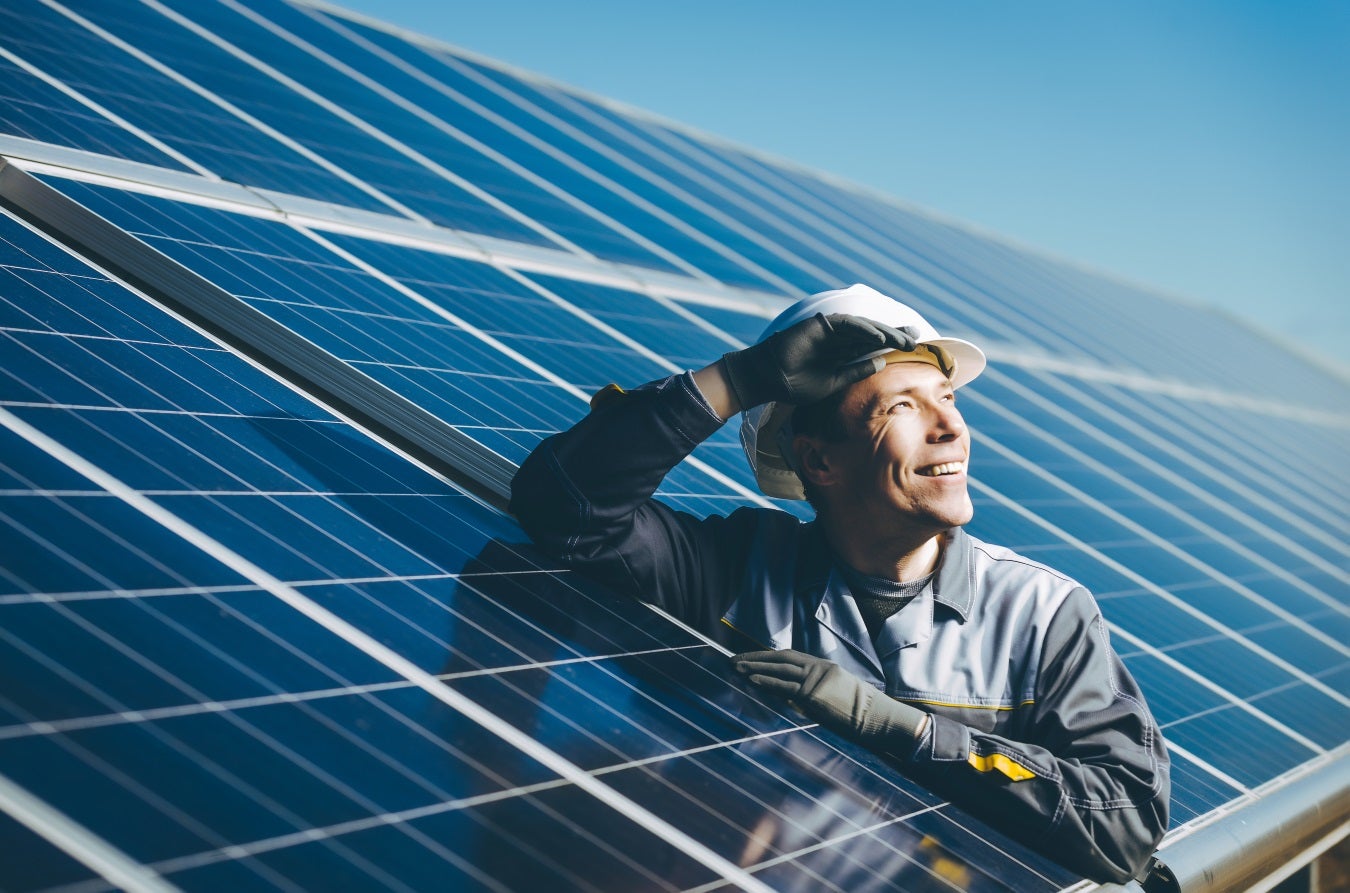
The number one factor stopping people from committing to solar energy is, of course, cost. After all, you’ve got to eat, pay the mortgage, and generally survive, just like everyone else. However, there’s good news: experts have stated that grid parity – the point at which you’re paying the same for solar energy as you would for power from the National Grid – will be achieved during the early 2020s.
In many ways, the revolution around solar costs has already begun. In August 2018, it was announced that the first British unsubsidised solar farm will be built in Oxfordshire. The business park is intended to be carbon-neutral, with excess power sold to the grid.
On top of this, 2020 saw the introduction of the Smart Export Guarantee, an initiative which allows you to sell excess energy to the government. This means that after your initial investment in solar panels, you won’t just be saving on electricity costs; you could also make extra money on top of that.
Jack Dobson-Smith of the Solar Trade Association told The Eco Experts: “For households, the cost of solar has fallen considerably.”
“
[Solar energy]
empowers people to take meaningful action on climate change, while also saving on their energy bills.”
If that sounds good to you, fill in this short form to find out how much you could save.
The Complete Guide to Solar Energy: what’s on this page?
Head straight to a specific section by clicking the links below.
- 01 | How has renewable energy evolved?
- 02 | What is solar power?
- 03 | Types of solar energy
- 04 | How does solar power work?
- 05 | How is solar energy stored?
- 06 | Solar energy facts
- 07 | The advantages and disadvantages
- 08 | Solar power vs non-renewable sources
- 09 | Solar power vs other renewable sources
- 10 | Should you get solar power for your home?
How has renewable energy evolved over time?
First, a bit of background. Renewable energy has come so far over the past few decades, to the extent that it’s poised to overhaul fossil fuels and provide the Earth with a cheaper, cleaner source of energy that combats climate change.
This is reflected in the fact that the UK has drastically cut its reliance on fossil fuels in recent times. In June 2019, the National Grid reported that 2019 would be the first year in which the country uses more electricity from renewable sources than fossil fuels.
National Grid CEO John Pettigrew emphasised that the aim was to rely entirely on renewable sources, saying: “Having reached this landmark tipping point, the question is, what are we doing today to get to net zero as quickly as possible?”
The speed of this shift has been startling, with fossil fuel usage falling by 29 percentage points between 2009 and 2019, while usage of renewable sources more than doubled during the same period.
The move away from fossil fuels has also been noticeable across the world, with production of renewable energy rocketing up by more than 250% between 1992 and 2016. The International Energy Agency has stated that renewable energy will supply 12.4% of the world’s energy needs by 2023 – and that’s just the beginning.
Costs associated with renewable sources like solar energy are also falling, with the International Renewable Energy Agency (IRENA) predicting that at some point in 2020, renewable power will be consistently cheaper on a global scale than fossil fuel-fired energy.
This is because global investment in renewable energy has risen massively as technology and attitudes have developed. In 2004, £31.7 billion was invested in renewable energy across the world – in 2017, this figure was £262 billion. That’s an increase of more than 800% in just 13 years.
According to international thinktank REN21, solar power has played a large part in this, with solar investments increasing more than fiftyfold from 2004 to 2014. REN21 has also reported record years of growth for solar capacity in 2015, 2016, and 2017.
As solar power systems have become more effective, more widespread, and more trusted by the public, governments, and investors, they have multiplied at an astonishing rate. In 2017, solar PV capacity expanded by 98GW, according to the United Nations. This was more than any other renewable source, and more than all fossil fuels combined.
In the same year, the European Union reported that in the space of a decade, prices for residential grid-connected PV systems had gone down by 75%.
The recent energy crisis has also led more people to consider renewable energy. Our National Home Energy Survey found that 78% of Brits want the UK government to invest in more renewable energy.

Nadia Smith, a policy analyst at the Renewable Energy Association (REA), told The Eco Experts that this trend towards cheaper solar systems is here to stay.
“Costs have decreased considerably, and as technology sophisticates, this decrease is expected to continue,” she explained. “In the meantime, the Smart Export Guarantee offers consumers a price per kW for their exported power, ensuring those with solar panels are rewarded for their socially responsible decision.
“Reductions in the cost of battery storage, as well as complementary products in the ‘smart home’ package, also improve these economics.”
The growing popularity and economic wisdom of choosing solar energy over fossil fuels is clear, but what’s less obvious to most people is how solar works, how best to harness it, and what sets it apart from other renewable sources. Don’t worry, though – we’ve got you covered.
Solar energy: what is solar power?
Solar power comes from taking the sun’s energy and converting it into electricity. It’s a renewable energy source, meaning that it is practically infinite – unlike fossil fuels. Solar energy also doesn’t release harmful pollution, and barely contributes to climate change, according to a study in the Nature Energy journal.
Types of solar energy
There are two main types of solar energy: photovoltaic (PV) and thermal. PV systems convert sunlight directly into electricity. Thermal solar systems use the sun’s heat to warm up water.
Where do you want to install solar panels?
Get startedHow does solar power work?
When you think of solar energy, your mind probably conjures up images of PV systems, which work using solar panels that are mounted on your roof or across a large expanse of ground. These panels are made up of solar modules, which in turn contain solar cells made of silicon. These cells take the sun’s light and convert it into direct current (DC) electricity through a process known as the photovoltaic effect.
A piece of hardware known as a solar inverter then converts this DC electricity into alternating current (AC), which is able to power your home. If any electricity is left over, you can sell it to the National Grid, and make a tidy sum for yourself.
There are several types of solar panels.
Monocrystalline cells are the most expensive, but do have the advantage of being the most efficient – plus they look sleeker to some than their counterparts.
Polycrystalline panels are less efficient, though they do have a similar lifespan.
Thin film panels – a relatively new invention – are cheaper, but less energy efficient, and have a significantly shorter estimated life expectancy.
Thermal solar systems utilise the sun’s heat – which gets up to 15 million degrees Celsius at its core – to make your home warmer. To achieve this, they either use evacuated tubes or flat plates. When employed on a larger, commercial scale, thermal solar energy can provide electricity to thousands of homes.
Evacuated tubes contain a vacuum and are made of glass, with a tube of water running down the middle with a metal absorber plate, which conducts heat from the sun. This heats the water, which is then pumped to the rest of the home.
Flat plates are insulated metal boxes covered with glass or plastic that have pipes running through them. They trap heat, warm up the water in the pipes, and then supply this hot water straight to your home to fulfil your general heating needs.
What’s even better is that neither form of solar energy requires direct sunlight to absorb energy. Even if it’s cloudy, they still generate power.

How is solar energy stored?
Instead of selling all of your excess solar energy to the grid, you can use solar batteries to store some of it for future use. If your panels are taking on more energy than you need, it’ll be redirected to charge your batteries, so that you can benefit from solar energy at night.
You can choose between lithium-ion batteries – which are more effective, but cost more – and lead-acid batteries, which are cheaper, but typically half as effective as their more modern counterpart.
Whichever you choose, they’ll work in the same way as any battery: power goes in, and then comes out when you need it. And when they’re full, your system will send any additional energy to the grid, meaning you’ll save even more money on energy costs. This excellent setup explains why YouGov found that 60% of people in the UK would like to install a storage battery at home.
Solar batteries also have the advantage that they can provide power if there’s an outage in your local area. The only issue then will be dealing with your jealous neighbours. If that’s not a drawback for you, fill in this form to receive a competitive quote for solar panels.
Solar energy facts
• The photovoltaic effect was discovered by French physicist Alexandre Edmond Becquerel in 1839.
• The patent for the first solar cell was filed by American engineer Russell Ohl in 1941.
• In 1979, President Jimmy Carter installed the first solar panels on the White House.
• In 2016, Swiss explorers André Borschberg and Bertrand Piccard completed the first round-the-world journey in a solar-powered plane, called the Solar Impulse 2.
• In 2000, a report from the UN found solar power had the potential to produce a minimum of 1,575 exajoules of energy per year, and a maximum of 49,837. To put that in context: in 2015, the Earth created 572 exajoules of energy, according to the UN. Therefore, if it reached its potential, one year’s worth of solar energy could power the Earth for 87 years.
• Solar power generation grew 29% in 2018, according to BP.
• Solar energy’s share of global power generation has more than doubled in just three years.
• Solar PV is the second-cheapest energy source, according to Deloitte.
• According to a 2019 report from IRENA, global electricity costs from utility scale solar PV projects have fallen by 73% since 2010.
• Solar PV is also the fastest-growing alternative energy source, according to the International Energy Agency (IEA).
• The IEA has predicted that by 2023, Solar PV capacity will increase by nearly 600GW – more than all other renewable energies combined.
• IRENA reckons that solar energy capacity will make up 35.4% of the Earth’s capacity by 2050.
Solar energy: the advantages and disadvantages
The main advantages to hopping on the solar train are that you’ll be helping to fight climate change, constantly saving money after your initial investment, and set to benefit from grid parity, which is, by multiple estimates, just around the corner.
A 2018 study by the Renewable Energy Association and accounting firm KPMG predicted that domestic and commercial solar PV will reach grid parity by 2023, while consultancy firm Aurora Energy Research has stated that solar projects in the UK could be viable without subsidies by the early 2020s.
Some have gone even further. Dr Pegah Mirzania, a research fellow at Cranfield University, told The Eco Experts that grid parity will come into effect by 2022 – “That’s when solar PV electricity will have the same cost as fossil fuels.”
Policy analyst Nadia Smith said the REA had found that “grid parity will take place across all sectors during the 2020s, and the trajectory of solar costs means we appear to be on course to do that.”
Considering that solar panels can now reduce your monthly energy bill by nearly 62% – and potentially more if you have a solar battery to store excess power – it already seems worth it.
Smith pointed out that as well as being increasingly good for your wallet, solar panels are also “long-lasting – maintaining them should be restricted to an occasional clean.”
She added that they result in “no noise and no carbon emissions,” which means “less noise pollution and better air quality.”
Professor Chris Sansom, a senior lecturer at Cranfield University, told The Eco Experts he “can’t think of any negatives” associated with adopting solar energy for your home, emphasising that he would recommend both PV and thermal systems.

“It makes commercial sense to do it, and the other arguments in terms of climate change and having more local energy generation all suggest that it will be a good thing to have PV panels on your house,” he said.
“Assuming you want to use renewable energy for good social and environmental reasons, certainly the cheapest forms of producing electricity in a domestic setting are onshore wind and PV. I think PV just wins, but onshore is also good.
“You would probably choose PV, because it’s much easier to put panels on your roof than turbines in your garden,” he added.
When it came to thermal solar energy, the professor pointed out that “in your homes, you use more than 50% of energy on heat, so using thermals – which are usually cheaper than PV – to heat your water is also worth considering. I would recommend thermals.”
The only disadvantages, Dr Sansom said, were not knowing what the energy landscape will look like after Brexit, and that people don’t always stay in a house for long enough to gain the full benefits of harnessing solar energy.
This is down to the initial investment being off-puttingly high for anyone not planning on staying in their home for the long term. A solar panel system for a three-bedroom household costs £7,026 in the UK on average, and though you have to spend money to make money, you won’t profit if you don’t stick around to reap the rewards.
And the good news is that the starting cost of solar panels is falling. According to UK government statistics, the price of residential solar panels has dropped by more than 50% since 2011.
Solar power vs non-renewable energy sources
As mentioned above, solar PV capacity rose more in 2017 than for all fossil fuels combined. Solar is on the rise, and for good reason – it’s a clean, renewable way to power your home, and you could even make some money in the process.
This practically infinite source of energy will return on your investment eventually, unlike oil, coal, or natural gas. The fossil fuel industry doesn’t just exploit the natural world for resources; it also holds you over an oil barrel when it comes to charging you for the privilege of powering your home or car.
In contrast, solar energy allows you to escape the stranglehold of fossil fuels and install your own source of power, allowing you to take a big step towards self-sufficiency. This is especially good for anyone who lives in a rural area, or who’s just fed up with paying steep energy prices.
The solar energy sector is also a job creation powerhouse. It hires 40% of the people who work in renewable energy, according to IRENA, which in 2018 added up to 4.4 million employees – and this number is growing. The number of solar workers has also doubled in just the past six years.
You can invest in solar power, safe in the knowledge that your energy usage won’t lead to deadly pollution. The latest data shows that air pollution resulting from coal alone leads to the premature deaths of 800,000 people per year.
Fossil fuels also contribute to climate change, with the industry pumping out 37.1 billion tonnes of global CO2 emissions in 2018. Solar energy production results in a negligible amount of CO2 – unlike oil, coal, and natural gas, which have already exacerbated the number and strength of hurricanes, floods, and wildfires around the globe.
Fossil fuels have also contributed to a rise in the average temperature, which is dangerous. A United Nations report in 2018 found that by the time 2100 rolls around, “a 1.5°C average rise may put 20-30% of species at risk of extinction. If the planet warms by more than 2°C, most ecosystems will struggle.”
A 2017 University of Washington study based on the data in this UN report found there was a 90% chance of this 2°C rise occurring. If it does, low-lying islands could be entirely submerged. The UN has stated that a sea level rise of just 0.5m could displace a total of 1.2 million people from these countries.
Fossil fuel production often directly results in disasters, too, such as oil spills, coal mining explosions, and gas fires. These catastrophes have historically resulted in thousands of deaths and billions of barrels of oil being released into the natural environment. There is no plausible equivalent when it comes to solar power.
Fossil fuels still make up around 80% of the world’s energy consumption, but that number has been consistently falling, and is set to keep plummeting. Get a quote for solar panels, and embrace a renewable alternative that can help save animals, humans, and countries from disaster.

Solar power vs other renewable energy sources
Any renewable source of energy is fuelled by a free, clean source of power. Any of them will help you to reduce your energy dependency on big companies and fight back against climate change. But some are more effective than others, and some will suit you especially well – or not.
Solar energy comes at a price, at least at first – but that’s true of any renewable energy source, and bringing solar power into your home will help you save money in the long run. The especially good news in that area is that solar PV costs have dropped by 88% in the US since 2009, according to analysis released in 2018.
There’s no reason this trend won’t continue – in fact, the National Renewable Energy Laboratory has predicted that utility solar PV costs will decline another 60% by 2050.
Wind power
Solar energy is certainly more viable than wind power on an individual basis. Though wind costs have fallen by nearly as much as solar PV (69% since 2009), and turbines are very cost-effective, this only applies on a large scale. Wind turbines aren’t easy to set up in your garden, unless you own the kind of property that wouldn’t look out of place on Downton Abbey.
It may not be right for you or your family, but wind power has enormous potential to revolutionise the energy which flows into your home. A 2017 study showed that enough offshore wind turbines could be installed in Britain by 2030 to power 75% of homes. This potential has been demonstrated by Scotland, which generated enough wind energy in the first half of 2019 to power two Scotlands.
And if you’re worried that wind turbines kill birds, unfortunately they do – but not that many, relatively. A 2014 study in the US found that 10,000 times more birds are killed by domestic cats than by wind turbines – and the latter are getting safer all the time.
Hydro power
In a similar way, hydro power has been able to meet the majority of several countries’ power needs, including ones as diverse as Albania, the Democratic Republic of the Congo, and Paraguay. However, hydro is practically impossible to install yourself, unless you have millions of pounds and clearance to build a dam.
The good news for hydro is that – like many renewable sources – after its expensive setup, the profits pour in. It doesn’t require many workers to oversee operations, or much money for maintenance. A drought can affect the amount of energy which is available, but this is comparable to instability in the global oil market.
Tidal power
Tidal power also falls down in terms of individual usage, meaning that solar energy is still the better choice for you and your family. However, unlike hydro, the tides are predictable, making it easier to plan around than wind or solar energy.
Tidal is a new source of energy, and only produced 0.5 GW in 2018 – which is more than 1,000 times less than the amount of solar energy created. Because it was developed so recently, the costs of tidal power are still high – but countries including France, the UK, South Korea, and Canada have all seen the potential and built their own hydropower plants.
As with all energy industries, it will become cheaper over time as the technology improves, and more nations will follow suit when it does.
Geothermal energy
You can also harness geothermal energy for your home, in the form of a ground source heat pump, but a typical system will set you back as much as £18,000, according to the Energy Saving Trust. It’ll also cost around £1,000 per year in service and running costs.
Though it’s expensive on a small scale, IRENA reckons that geothermal energy has the potential to fuel the entire world. The heat present in the 10,000 metres under the Earth’s surface reportedly contains an estimated 50,000 times more energy than all the oil and gas resources in the world.
And with some saying that energy infrastructure can be an eyesore, it’s an added bonus that geothermal facilities don’t need to be as visible, as they can be built partially underground.
The main drawback, especially when compared to solar energy (which doesn’t produce disasters), is that geothermal drilling can lead to earthquakes, as steam released from inside the Earth sometimes creates increased instability along fault lines.

It’s also only cost-effective in certain areas, where geothermal energy is easiest to produce. For instance, Kenya, Iceland, and the Philippines have benefited hugely from taking advantage of their geothermal potential – but other countries don’t have the same resources to mine. In contrast, solar energy can be accessed from anywhere, by anyone.
Heat pumps
Air source heat pumps, which work by capturing ambient heat, cost between £7,000 and £13,000. However, the running costs can set you back thousands more every year, and they require annual maintenance.
If you’re prepared to dip in your pocket, these pumps are very efficient at converting energy to heat, and are able to either cool or heat your home. They can also last two or even three decades, which is on the same level as solar panels.
Their popularity is also increasing, according to REN21 – more than 1.2 million units were sold in Europe in 2018, representing a 12% increase from 2017.
See our guide on air source heat pump costs for more information on what you might pay.
Biofuels
Biofuels are cutting the need for fossil fuels in the transport industry, but they’re not really practical to produce for home use.
This is mainly because they require land and water, which reduces the resources available to grow food crops. In contrast, many other renewable sources don’t need anything extra – wind and sunshine don’t need to be grown; they come ready-made.
The production of biofuels also often creates more carbon emissions than other renewable sources of energy, as farming often depends on fossil fuels.
On the plus side, biofuels are relatively easy to transport and can be grown nearly anywhere, which makes them much more flexible than tidal or geothermal power. This is reflected in the fact that ethanol production grew by 8% in 2018.
Waste-to-energy
If you’re not interested in creating a new energy resource, you might be more enthusiastic about making fuel from literal garbage. This magical-sounding process is known as waste-to-energy, and is growing in popularity – though like many energy sources, it’s not available to the individual.
Waste-to-energy provides a steady and controllable output of electricity, as it doesn’t rely on nature and there are no wild fluctuations in the availability of waste – humans are pretty predictable when it comes to creating rubbish.
It’s recycling in its purest form. Instead of going to a landfill, where the waste would’ve emitted methane and contributed to climate change, it goes into creating clean energy.
With metals recovered for other uses instead of going to landfills, waste-to-energy could potentially reduce the need for landfill sites. This could see these areas freed up to be used for other, more environmentally friendly purposes.
Should you get solar power for your home?
And so, we come to the question which matters most to you. Solar energy is all very well in theory, but does it suit your needs?
Dr Philipp Thies, a senior lecturer in renewable energy at Exeter University, told The Eco Experts that “it depends very much on the location of your house and the site’s conditions.
With a good location, and good roof space and sunshine, it’s cost efficient. You’d need a south-facing roof, and solar panels which produce at least in the order of 5-10 KW.”
He emphasised that solar energy was “one of the most cost-effective technologies at the moment. It’s come down significantly over the past couple of years.”
And when it comes to fighting climate change, Dr Thies said that solar energy was an excellent tool.
“It’s low carbon,” he said, “so if you generate electricity through solar panels, it’s typically within 10 to 12 months that you’re reducing carbon.
“Any electricity generated after that will offset carbon. That’s very important, because we’re obviously producing too much carbon, so anything we can do to lower carbon emissions is a good thing.”
Saffa Riffat of Nottingham University – who is also president of the World Society of Sustainable Energy Technologies – agreed that solar energy was particularly effective on an individual basis.
“I would recommend it,” he told The Eco Experts. “It’s a very attractive source of energy. Wind energy is good for cost, but not in the city centre.”
The REA’s Nadia Smith agreed, reporting that “consumers are becoming more enabled to transform into prosumers (people who create and use their own energy). Solar is becoming a part of a wider package for homes, offering the foundation of clean, cheap, low carbon electricity generation.”
If you’re excited about the ways in which you could help the planet (and your wallet) by adopting solar energy, you can fill in this form to get a quote for solar panels from one of our high-quality suppliers.

